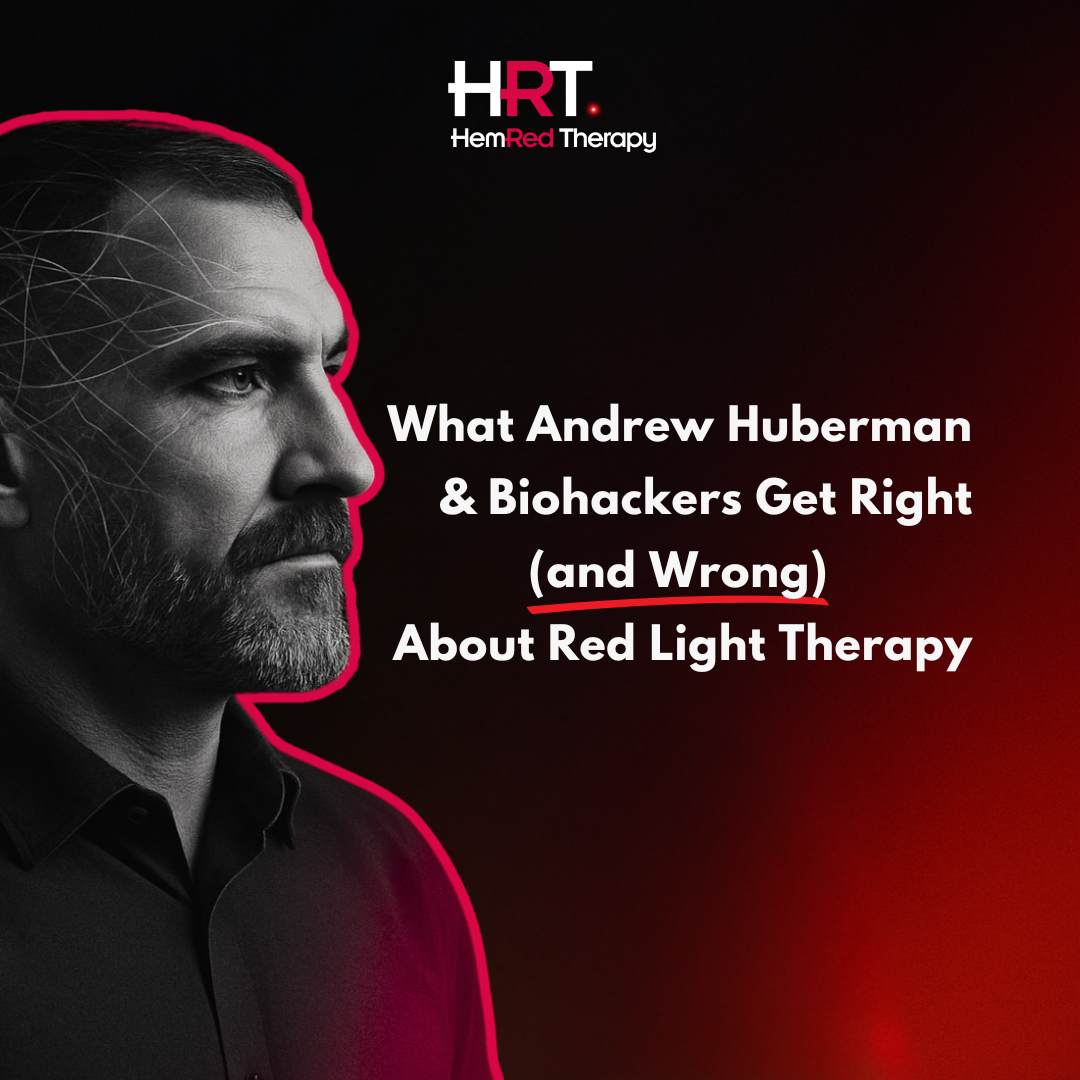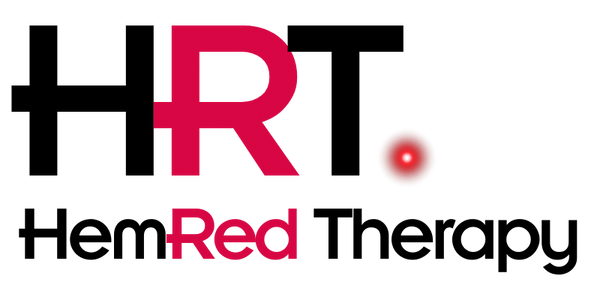
What Andrew Huberman & Biohackers Get Right (and Wrong) About Red Light Therapy
What Andrew Huberman & Biohackers Get Right (and Wrong) About Red Light Therapy
TL;DR
Andrew Huberman has helped millions understand how light affects the body. His support of red and near-infrared light therapy (aka photobiomodulation) is grounded in science. But too many fans and influencers conflate science with price. This expert analysis breaks down what the research really says, what most biohackers get wrong, and how panels like the HemRed Therapy™ PureLight 225 match clinical-grade output at a fraction of the cost.
1. What Andrew Huberman Actually Says About Red Light Therapy
Dr. Andrew Huberman is a neuroscientist at Stanford University and host of the Huberman Lab Podcast, which regularly explores light and its effects on circadian rhythms, performance, and recovery. While he does not promote any one device or brand, he has publicly endorsed the mechanisms and potential benefits of red light therapy.
Core Claims from Huberman (Cited Episodes):
- ATP Enhancement: Red and NIR light stimulate cytochrome c oxidase in mitochondria, increasing cellular energy.
- Mood and Circadian Effects: Red light may help regulate melatonin when used strategically.
- Anti-Inflammatory Effects: Evidence shows reduced NF-κB activation and systemic inflammatory markers.
- No Endorsement Bias: Huberman has emphasized that many red light benefits can be achieved without expensive devices.
“Red and near-infrared light, when used properly, can be a powerful tool to modulate biology—but more is not always better.” — Huberman Lab Podcast, Episode 103
Takeaway: Huberman supports red light therapy when used correctly and warns against hype or excess.
2. What the Latest Science Says (2023–2025)
Red light therapy (RLT) is supported by over 6,000 peer-reviewed publications. In the last two years, high-quality meta-analyses have confirmed RLT's efficacy across several areas:
Key Evidence Areas:
- Muscle Recovery: 2024 meta-analysis in Lasers in Medical Science showed a 30-50 % reduction in DOMS when using 660 + 850 nm light post-exercise.
- Joint Pain: RLT down-regulates inflammatory cytokines (TNF-α, IL-6) and up-regulates collagen I/III in connective tissue.
- Skin Rejuvenation: Clinical trials report increased fibroblast activity, reduced fine lines, and improved hydration with consistent 6–8 min sessions at 6–12 inches.
Takeaway: Red light therapy is not a wellness trend—it’s a validated, dose-sensitive modality with clinically proven benefits.
3. Where Biohackers (and Influencers) Go Wrong
Many biohackers use RLT daily, but common mistakes persist:
- Overdosing: Going beyond 10–15 minutes per area can trigger an inhibitory biological response.
- Misplaced Panels: Treating the wrong region (e.g., using facial panels for deep muscle recovery).
- Wavelength Ignorance: Using generic LED masks with only 630 nm red light instead of 660 + 850 nm.
- Brand Obsession: Believing expensive = effective, when irradiance and dosage are the real metrics.
Example: An $80 panel with >100 mW/cm² @ 6″ is more therapeutic than a $500 brand with poor irradiance spread.
Takeaway: Red light therapy works—but only when used with precision, not influencer aesthetics.
4. Protocols That Work (and Why)
Muscle & Recovery
- Pre-Workout: 3 min @ 6 inches (ATP + blood flow)
- Post-Workout: 8–10 min @ 6–12 inches (DOMS reduction)
- Rest Day: 10–12 min @ 12 inches (tendon + joint repair)
Skin Health
- Daily: 5–6 min @ 6 inches (face/neck, eyes closed)
- 3–5× per week: Consistency > intensity
Cognitive + Mood
- Morning: 5–8 min behind neck/top of spine, 3× weekly
Takeaway: Clinical benefit = correct wavelength + distance + time + consistency.
5. You Don’t Need a $300+ Panel
Many panels promoted by influencers cost between $300 and $600, but often lack:
- Verified irradiance output
- Balanced 660/850 nm ratio
- Warranty or trial guarantees
Comparison Table
| Feature | PureLight 225 | Popular “Premium” Panels |
|---|---|---|
| Wavelengths | 660 + 850 nm (1:1) | Same |
| Irradiance | >110 mW/cm² @ 6 in | 60–120 mW/cm² |
| Coverage | 12.2″ × 12.2″ | 6″ × 10″ (typical) |
| Price | $79 | $299–599 |
| Warranty | 2 yrs + 30-day trial | 1 yr (avg) |
View product: HemRed Therapy™ PureLight 225
Takeaway: Performance isn’t about price. Our panel delivers what matters: dosage, spectrum, and reliability.
6. Testimonials from the Field
“I used to deal with quad soreness after rugby training. 10 minutes with the PureLight 225 post-session, and I’m back on the field faster.” — Jonas, Toronto
“I replaced my $450 mask with the PureLight. My skin saw the same results, and I saved hundreds.” — Rebecca A., London
“I manage osteoarthritis flare-ups with light therapy now—and I finally ditched NSAIDs.” — Mike B., Denver
7. FAQ
-
Does Andrew Huberman personally endorse red light therapy?
No specific brand, but he supports the mechanism and discusses it in detail across episodes. -
What wavelength is best?
A combination of 660 nm (surface skin & cell energy) + 850 nm (deep joint & muscle). -
How many minutes per session?
Optimal window is 5–10 min per area. More is not better. -
Can RLT help hormones?
Early studies suggest testosterone and thyroid support, but results vary and are still under research. -
How soon should I expect results?
Skin changes: 1–2 weeks. Pain/muscle recovery: noticeable within 5–7 uses.
8. Final Takeaways
Photobiomodulation is no longer fringe science. Huberman helped put light on the map, but it’s time the conversation evolved. With the right protocol, an affordable panel like the PureLight 225 delivers the same mitochondrial, musculoskeletal, and dermal benefits at a radically more accessible price.
Explore the panel trusted by hundreds:
HemRed Therapy™ PureLight 225
9. Sources
- Huberman Lab Podcast Episode 103 – “Light for Health & Performance” (2024)
- Hamblin MR. Photobiomodulation Mechanisms. Photochem Photobiol Sci. 2023.
- Bjordal JM et al. Low-Level Laser Therapy in Sports Recovery. Lasers Med Sci. 2024.
- J. Sports Med Meta-Review (2025) – Red Light Therapy on Skeletal Muscle Performance.
- ClinicalTrials.gov Identifier NCT05678912 – Red/NIR for Knee Osteoarthritis (2024, Phase II).
Author: Dr. Jonas Lundström
Certified Sports Physiotherapist | Nordic Biohacking Society
Independent reviewer of photobiomodulation protocols (2023–25)
